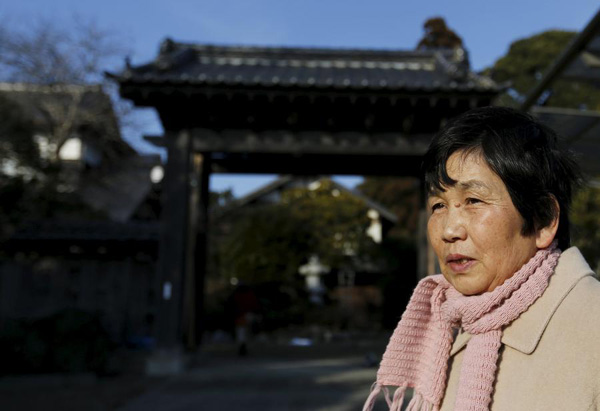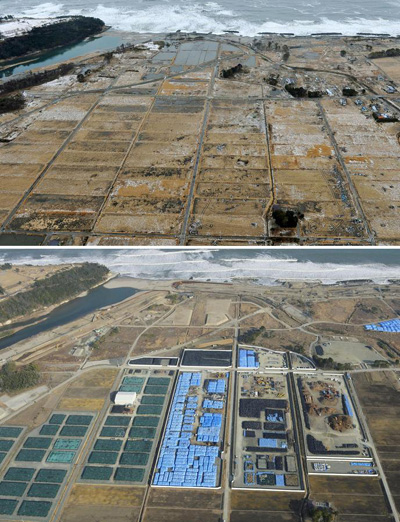Japan's nuclear refugees face bleak return 5 years after Fukushima
Updated: 2016-03-03 09:51
(Agencies)
|
||||||||
Other workers are building a new sea wall, 8.7 metres high, along a nearly 2 km stretch of Naraha's coast, similar to other sea walls under construction in the northeast.
A local golf course has been turned into dormitories for workers. Some families have rented their houses to workers.
"Naraha is a workers' town now," said Kiyoe Matsumoto, 63, a member of the town council, adding that her children and grandchildren have no plans to come home.
|
 |
|
Kiyoe Matsumoto, 63, a local politician who has served the town for 15 years, speaks to Reuters in front of a gate of her home in Naraha, Fukushima prefecture, Japan, February 12, 2016. Picture taken February 12, 2016. [Photo/Agencies] |
RADIATION LEVELS
The town's future depends on young people returning, residents say. But only 12 below the age of 30 have returned as worries about radiation linger.
Radiation levels in Naraha ranged from 0.07 to 0.49 microsieverts per hour in January, or 0.61-4.3 millisieverts per year. That compares with the government's goal of one millisievert a year and the 3 millisieverts a year the average person in the United States is exposed to annually from natural background radiation.
The significant drop in atmospheric radiation allowed the government to lift the evacuation order last Sept. 5 - "the clock that had been stopped began ticking again," Japan's Reconstruction Agency said on its website.
"It is hoped that the reconstruction of Naraha would be a model case for residents returning to fully evacuated towns," the agency statement said.
|
 |
|
An aerial view shows the tsunami-devastated Naraha town, near the tsunami-crippled Fukushima Daiichi nuclear power plant, in Fukushima prefecture, is seen in February 26, 2012 (top) and February 12, 2016, in this combination picture released by Kyodo on February 26, 2016, ahead of the five-year anniversary of the March 11, 2011 earthquake and tsunami disaster. [Photo/Agencies] |
Prime Minister Shinzo Abe visited the town a month after that and repeated one of his favourite slogans: "Without reconstruction of Fukushima, there's no reconstruction of Japan's northeast. Without the reconstruction of the northeast, there's no revival of Japan."
But with few people coming back, there is little meaning in what the reconstruction department in Naraha does, said one town hall official who requested anonymity. "I don't know why (Abe) came," he said.
Back at his Buddhist temple, part of which he has turned into an office for his anti-nuclear campaign, Hayakawa called the idea Naraha could be a model of reconstruction "a big fat lie".
"There's no reconstructing and no returning to how it used to be before (March 11). The government knows this, too. A 'model case'? That's just words."
($1 = 113.1100 yen)

 China's first large passenger plane poised for maiden flight
China's first large passenger plane poised for maiden flight
 Clashes break out as France begins clearing Calais migrant camp
Clashes break out as France begins clearing Calais migrant camp
 Top 10 cities with most billionaires in 2016
Top 10 cities with most billionaires in 2016
 Milan Fashion Week: Dolce & Gabbana Autumn/Winter 2016 collection
Milan Fashion Week: Dolce & Gabbana Autumn/Winter 2016 collection
 Top moments from Oscars 2016
Top moments from Oscars 2016
 China Daily weekly photos: Feb 20-26
China Daily weekly photos: Feb 20-26
 People view plum blossoms at scenic area in E China
People view plum blossoms at scenic area in E China
 Rural e-commerce developed to promote local products in SW China
Rural e-commerce developed to promote local products in SW China
Most Viewed
Editor's Picks

|

|

|

|

|

|
Today's Top News
What ends Jeb Bush's White House hopes
Investigation for Nicolas's campaign
Will US-ASEAN meeting be good for region?
Accentuate the positive in Sino-US relations
Dangerous games on peninsula will have no winner
National Art Museum showing 400 puppets in new exhibition
Finest Chinese porcelains expected to fetch over $28 million
Monkey portraits by Chinese ink painting masters
US Weekly

|

|








